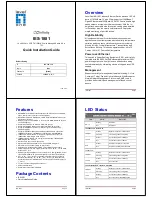
2-2
device moves between these networking environments, you just need to specify the corresponding
configuration file as the startup configuration file for the next boot of the device and restart the device,
so that the device can adapt to the network rapidly, saving the configuration workload.
Startup with the Configuration File
The device takes the following steps when it boots:
1) If you have specified a startup configuration file for system startup, and this file exists, the device
will initialize its configuration based on this file.
2) If the specified startup configuration file does not exist, the device will boot with null configuration.
Saving the Current Configuration
Introduction
You can modify the current configuration on your device using command line interface. However, the
current configuration is temporary. To make the modified configuration take effect at the next boot of the
device, you must save the current configuration to the startup configuration file before the device
reboots.
Enabling Configuration File Auto-Save
1) Distributed
device
z
After the configuration file auto-save function is enabled, when you save the current configuration
by executing the
save
[
safely
] command
or executing the
save
filename all
command and then
pressing
Enter
, the AMB and SMB will automatically save the current configuration to the specified
configuration file, and use the file as the configuration file for the next startup, thus keeping the
consistency of the configuration files on the AMB and SMB.
z
If the configuration file auto-save function is not enabled, when you save the current configuration
by executing the
save
[
safely
] command
or executing the
save
filename all
command and then
pressing
Enter
, only the AMB will automatically save the current configuration to the specified
configuration file, and use the file as the configuration file for the next startup; the SMB will neither
save the configuration file nor configure the file for the next startup.
2) Distributed IRF device
z
After the configuration file auto-save function is enabled, when you save the current configuration
by executing the
save
[
safely
] command
or executing the
save
filename all
command and then
pressing
Enter
, each main board of a IRF will automatically save the current configuration to the
specified configuration file, and use the file as the configuration file for its next startup, thus keeping
the consistency of the configuration files on the AMB and SMBs of the IRF.
z
If the configuration file auto-save function is not enabled, when you save the current configuration
by executing the
save
[
safely
] command
or executing the
save
filename all
command and then
pressing
Enter
, only the AMB of the IRF will automatically save the current configuration to the
specified configuration file, and use the file as the configuration file for the next startup; the SMBs of
the IRF will neither save the configuration file nor reconfigure the file for the next startup.
Follow these steps to configure the configuration file auto-save function:
To do…
Use the command…
Remarks
Enter system view
system-view
—
Содержание S7906E - Switch
Страница 82: ...1 4 DeviceA interface tunnel 1 DeviceA Tunnel1 service loopback group 1...
Страница 200: ...1 11 DeviceB display vlan dynamic No dynamic vlans exist...
Страница 494: ...ii Displaying and Maintaining Tunneling Configuration 1 45 Troubleshooting Tunneling Configuration 1 45...
Страница 598: ...ii...
Страница 1757: ...4 9...
Страница 1770: ...6 4...
Страница 2017: ...2 11 Figure 2 3 SFTP client interface...
Страница 2062: ...i Table of Contents 1 URPF Configuration 1 1 URPF Overview 1 1 What is URPF 1 1 How URPF Works 1 1 Configuring URPF 1 2...
Страница 2238: ...1 16 DeviceA cfd linktrace service instance 1 mep 1001 target mep 4002...
Страница 2442: ...2 4 Set the interval for sending Syslog or trap messages to 20 seconds Device mac address information interval 20...
















































